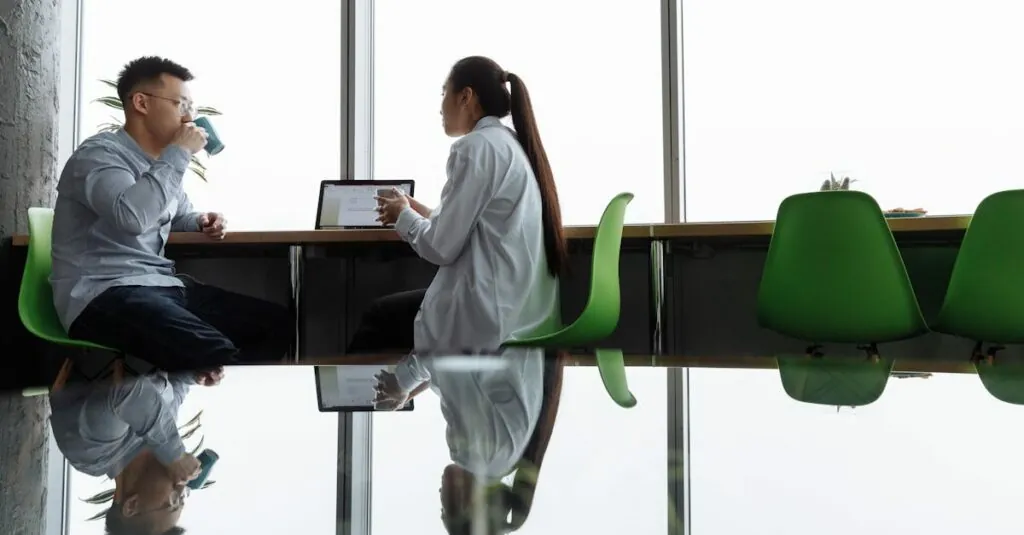Imagine zipping from one city to another faster than you can say “traffic jam.” Enter the Hyperloop, a futuristic mode of transportation that promises to make long commutes feel like a breezy Sunday drive. With sleek pods gliding through low-pressure tubes, it’s not just a pipe dream; it’s the next big thing in travel that could leave trains and planes eating its dust.
But what’s the deal with this sci-fi marvel? It’s not just about speed; it’s about redefining how we think about distance. The Hyperloop could revolutionize daily travel, making it so quick and easy that even your morning coffee might have to keep up. Buckle up as we dive into the fascinating world of Hyperloop technology and explore how it could change the way we connect with each other, one pod at a time.
Table of Contents
ToggleOverview of Hyperloop
Hyperloop represents a groundbreaking advancement in transportation technology, aiming to significantly cut travel times between urban centers. This concept involves pods that glide at high speeds through vacuum-sealed tubes. The low-pressure environment inside these tubes minimizes air resistance, allowing for velocities that could exceed 700 miles per hour.
Innovators believe Hyperloop could reshape commuter experiences. Passengers might enjoy a journey from Los Angeles to San Francisco in just over 30 minutes. Many proponents argue that such swift transit options will enhance economic growth by connecting businesses and individuals more efficiently.
Safety remains a critical focus in Hyperloop design. Developers prioritize passenger security through features like emergency braking systems and robust pod construction. Engineers continually explore ways to ensure the pods withstand external pressures and impacts.
Industry experts estimate that Hyperloop could become a viable alternative to traditional forms of transportation within the next decade. Several test tracks are already in construction or operational, demonstrating the technology’s feasibility. Investors show increased interest in supporting these projects, seeing potential for high returns and sustainable transportation solutions.
Sustainability plays a key role in this initiative, as the Hyperloop aims to utilize renewable energy sources. The system’s design allows for the integration of solar panels along the tube routes, promoting green energy use. As cities seek environmentally friendly transportation options, the Hyperloop’s eco-conscious approach aligns with global sustainability goals.
Emerging technologies paired with public interest signal a bright future for Hyperloop, promising to transform the way people travel.
How Hyperloop Works
Hyperloop utilizes advanced technology to transform transportation. It primarily relies on magnetic levitation and vacuum-sealed tubes to achieve high speeds.
Technology Behind Hyperloop
Magnetic levitation enables pods to glide above the track, eliminating friction. This technology significantly enhances speed and efficiency. Tube design allows for low-pressure environments that minimize air resistance. Pods operate inside these tubes, making travel faster than traditional methods. Power sources often include renewable energy, adding to sustainability. Developers combine these innovations to create a system that redefines travel.
Components of the System
The Hyperloop system consists of several key components. Pods serve as passenger carriers, designed for comfort and safety. Tubes, usually elevated, provide a pathway for rapid transit. Stations act as entry and exit points, ensuring seamless passenger experience. Energy systems power the technology, with solar panels integrated along routes. Safety mechanisms, including emergency brakes and structural reinforcements, prioritize passenger security. Each piece works harmoniously to create a revolutionary travel solution.
Advantages of Hyperloop
The Hyperloop presents several compelling advantages that could redefine modern transportation.
Speed and Efficiency
Traveling at speeds over 700 miles per hour, Hyperloop dramatically shortens commute times. Fast transit from Los Angeles to San Francisco might take just over 30 minutes. Passengers could enjoy swift travel, allowing for more time in their destinations instead of on the road. Efficiency enhances with the system’s design, as it operates in vacuum-sealed tubes that reduce air resistance. Magnetic levitation minimizes friction, contributing to faster and smoother journeys. Overall, this transportation solution optimizes routes and streamlines travel, making efficient commuting a reality.
Environmental Impact
Hyperloop emphasizes sustainability by integrating renewable energy sources. Solar panels along the tube routes promote green energy usage, significantly reducing carbon footprints. This eco-friendly approach aligns with global sustainability goals, offering an attractive alternative to traditional travel methods. Furthermore, compared to cars and planes, Hyperloop generates far fewer greenhouse gas emissions. Passengers can travel with peace of mind, knowing their journeys support environmental conservation efforts. By focusing on creating a transportation system that minimizes environmental harm, Hyperloop positions itself as a leader in sustainable transportation innovation.
Challenges Facing Hyperloop
Hyperloop faces several challenges that could impact its development and implementation. Key issues include engineering hurdles and regulatory issues.
Engineering Hurdles
Engineering challenges significantly affect Hyperloop’s progression. Designing vacuum-sealed tubes requires precise calculations to ensure structural integrity while handling extreme pressure differentials. Building pods that can maintain high speeds while ensuring passenger comfort and safety poses additional difficulties. Developers confront the need for advanced materials that can withstand wear and tear over extended use. Furthermore, establishing a reliable and efficient power supply system remains a hurdle; energy must be sustainable without compromising performance. Addressing these aspects is crucial for meeting operational requirements and ensuring a viable transportation alternative.
Regulatory Issues
Regulatory challenges impose significant barriers to the Hyperloop’s development. Each country has distinct transportation regulations that influence the approval process for new systems. Obtaining necessary permits can become a lengthy and complex procedure, complicating project timelines. Compliance with safety standards is non-negotiable and requires rigorous testing before public deployment. Engaging governmental bodies and local communities is essential for securing support and navigating public concerns effectively. Tackling regulatory issues directly impacts the overall timeline for bringing Hyperloop to market while ensuring safety and public acceptance.
Current Developments and Future Prospects
Current developments in Hyperloop technology are rapidly progressing with various companies working on prototypes and test tracks. Several projects, including Virgin Hyperloop and Elon Musk’s The Boring Company, are advancing toward operational systems. Test tracks have already begun construction in locations such as California and Texas, showing significant growth in this sector.
New innovations are being introduced to refine pod designs and enhance passenger safety features. Advanced materials are utilized to optimize weight and durability, contributing to overall efficiency. Safety protocols include comprehensive testing of emergency braking systems and structural reinforcements, emphasizing the commitment to passenger security.
Public interest and investment in Hyperloop projects continue to increase as various stakeholders recognize its potential. Stakeholders believe that the integration of renewable energy sources is crucial for future operations. Solar panels are increasingly incorporated along tube routes to support sustainable energy needs, aligning with the growing demand for eco-friendly transportation solutions.
Regulatory frameworks are evolving as more regions explore incorporating Hyperloop systems into their transportation infrastructure. Coordination with government bodies is essential to ensure compliance with local regulations and safety standards. Gaining public acceptance remains pivotal for the successful implementation of Hyperloop, requiring effective communication and community engagement.
Timelines for the Hyperloop’s commercial rollout vary, but many industry experts anticipate a fully operational system within the next decade. Feasible routes connecting major cities can transform daily commutes and stimulate economic growth. These advancements position Hyperloop as a game-changing transportation solution, promising faster, safer, and more sustainable travel for passengers.
The Hyperloop represents a groundbreaking shift in transportation that could redefine how people travel between cities. With its focus on speed safety and sustainability it stands to revolutionize daily commutes and economic connectivity. As development progresses and innovative technologies emerge the vision of a fully operational Hyperloop becomes increasingly attainable.
Investors and stakeholders are recognizing its potential to provide eco-friendly solutions for modern transportation challenges. With continued advancements and a commitment to safety and efficiency the Hyperloop is poised to become a vital part of the future transit landscape. The journey toward this new era of travel is just beginning and the possibilities are limitless.




